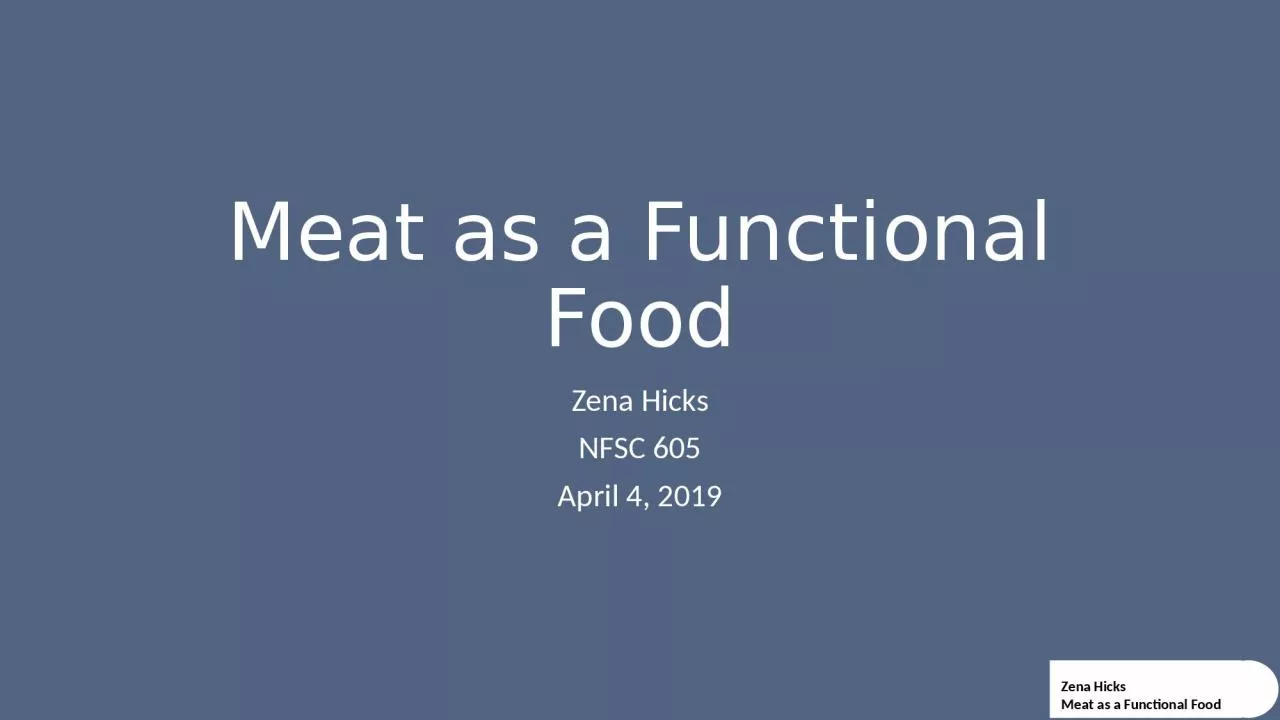

Zena Hicks NFSC 605 April 4 2019 Global Meat Consumption Kilogramscapita Organisation for Economic Cooperation and Development OECD Agriculture Statistics OECDFAO Agricultural Outlook Edition 2018 ID: 1048329
Download Presentation The PPT/PDF document "Meat as a Functional Food" is the property of its rightful owner. Permission is granted to download and print the materials on this web site for personal, non-commercial use only, and to display it on your personal computer provided you do not modify the materials and that you retain all copyright notices contained in the materials. By downloading content from our website, you accept the terms of this agreement.
1. Meat as a Functional FoodZena HicksNFSC 605April 4, 2019
2. Global Meat ConsumptionKilograms/capitaOrganisation for Economic Co-operation and Development - OECD Agriculture Statistics: OECD-FAO Agricultural Outlook (Edition 2018)
3. Red Meat in the Diet9.3% calories21.7% protein All 9 essential amino acids, Biological Value = 75-85%17.4% fatSFAs = 20.3%MUFAs = 18.7%PUFAs = 6.7%VitaminsA (17.5%), Niacin (18.1%), Riboflavin (13.1%), Thiamin (16.4%), Folate (4.3%), B6 (22.0%), B12 (58.5%), C (0.9%), E (2.0%)MineralsCalcium (1.3%), Phosphorus (14.6%), Magnesium (6.5%), Iron (10.6%), Zinc (30.4%), Copper (9.8%), Potassium (10.5%)
4. What is a functional food?“A food may be considered functional if it contains a component (be it nutrient or not) with a selective effect on one or various functions of the organism, whose positive effects justify that it can be regarded as functional (physiological) or even healthy.” – Pascal and Collet-Ribbing, 1998. “A food can be regarded as functional if it satisfactorily demonstrated to beneficially affect 1 or more target functions in the body, beyond adequate nutritional effects, in a way that is relevant to either improved health or well-being and/or to a reduction in the risk of disease. A functional food must remain food and it must demonstrate its effects in amounts that can normally be expected to be consumed in the diet: it is not a pill or capsule, but part of the normal food pattern.” – Fernandez-Gines et al. 2005
5. How can meat become a functional food?Adding ingredients considered beneficial for healthFresh meat productsInjections/marinadesProcessed meat productsRemoving/reducing ingredients that are considered harmfulProcessed meats
6. Pre-harvest diet manipulationsChanging fatty acids profile of the dietsIncreasing PUFA in meatSwineCattle and sheepAddition of alpha-tocopherolsAdded antioxidantLonger shelf life of productEffect for humans?
7. Pre-harvest diet manipulationsProbioticsBeta-agonistsNon-hormonal compounds fed that bind fat cell receptors and reduce or redirect fat metabolism or bind to muscle cell receptors to change muscle fiber sizeLeads to leaner, heavier carcassesZilpatoral (Zilmax), Ractopamine (Optaflexx) Hormone implantsIncrease growth and protein deposition Estrogenic or androgenic
8. Post-harvest interventionsAddition of different oilsOlive OilHigh oleic sunflower oilLinseed oilFish oilNutsAddition of soySoy protein isolates (SPI), Soy protein concentrate, soy isoflavonesAddition of natural antioxidantsRosemary, sage, tea, seasame seed, olives, grapes, citrus peelReduction of salt
9. Role of Fiber in Processed Meats ProductsDietary Fiber = “The edible parts of plants and analogous carbohydrates that are resistant to digestion and absorption in the human small intestine with complete or partial fermentation in the large intestine”Functions/AdvantagesWater binding 300 – 2,000% Oil absorption 200 – 600%Fat mimetic/replacerPossible DisadvantagesFlavorsColorsProhibition of fiber enrichment of meatsLabelling issues
10. Addition of FiberAssessment of vegetable based fibers in ground beef intended for international meat formulationsJ. Ball, J. Sawyer, B. Lambert, H. Ramirez, L. Adcock, R. Wyatt, J. Costilla, M.B. Mora GarciaTested different types of fiber (Oat, Pea, and Rice) with a control formulation. All batches included 78.1% beef, 17% water, 3.5% select vegetable fiber, 0.75% salt, 0.4% phosphate, 0.25% black pepperFound that all fibers added increased the shear force values compared to control Greater cook yields when fibers were addedAdding vegetable fibers increased surface L* values and decreased surface a* and b* values.
11. Addition of FiberAssessment of oat fiber technology in ground beef intended for international meat formulationsJ. Ball, J. Sawyer, B. Lambert, H. Ramirez, L. Adcock, R. Wyatt, J. CostillaTested different levels of oat fiber (0, 1.5, 3.5, and 4.5%) in a formulation including 17% water and fiber, 0.75% salt, 0.4% phosphate, and 0.25% black pepperFound that greater amounts of oat fiber lead to greater cook yields, lower cooked a* values, increased shear force values (P < 0.05).Greater cook times with 3.5 and 4.5% oat fibers.No changes in lipid oxidation with differing amounts of oats.
12. Addition of Fiber
13.
14. Future ApplicationsAdvantagesLower cost formulationsIncreased cooking yields, decreased incidence of persistent pinkingHealth appeal in labelling and marketing of productsInternational possibilities Possible roadblocksPublic perceptionRegulations/Labelling
15. SourcesBall, J., Sawyer, J., Lambert, B., Ramirez, H., Adcock, L., Wyatt, R., Costilla, J. Assessment of oat fiber technology in ground beef intended for international meat formulations. J. Meat Sci. 112:120-121. 2016. Ball, J., Sawyer, J., Lambert, B., Ramirez, H., Adcock, L., Wyatt, R., Costilla, J., Mora Garcia, M.B., Assessment of vegetable based fibers in ground beef intended for international meat formulations. J. Meat Sci. 112:121. 2016. Bodner, J. M., & Sieg, J. (2009). Fiber. In R. Tarté (Ed.), Ingredients in Meat Products: Properties, Functionality and Applications (pp. 83-109). New York, NY: Springer Science & Business Media.Fernandez-Gines, J.M., Fernandez-Lopez, J., Sayas-Barbera, E., Perez-Alvarez, J.A. Meat products as functional foods: a review. J. Food Sci. 70(2): R37-R43. 2005. OECD Agriculture Statistics: OECD-FAO Agricultural Outlook. (2018). Retrieved from Organization for Economic Co-operation and Development website: https://data.oecd.org/agroutput/meat-consumption.htmPascal, G., Collet-Ribbing, C. 1998. Las perspectives europeas sobre los alimentos funcionales. Institute for Prospective Technological Studies: Sevilla, Spain. IPTS Report 24:1-7. Petersson, K., Godard, O., Eliasson, A., Tornberg,E. The effects of cereal additives in low-fat sausages and meatballs. Part 2: Rye bran, oat bran and barley fibre. J. Meat Sci. 96:503-508. 2014.
16. Questions?